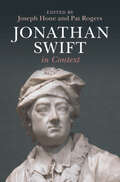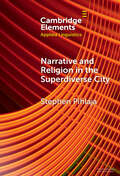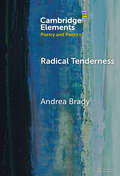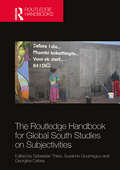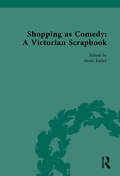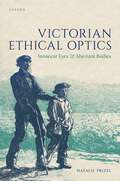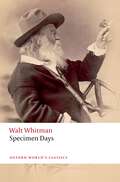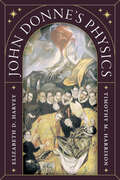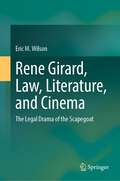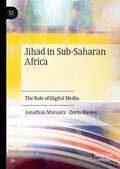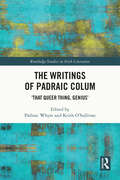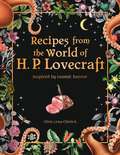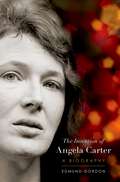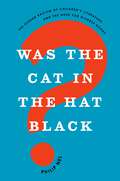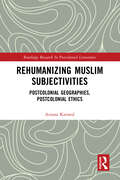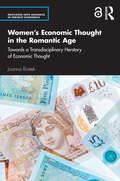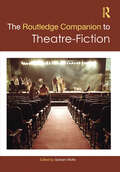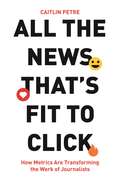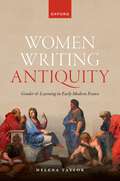- Table View
- List View
Jonathan Swift in Context (Literature in Context)
by Joseph Hone Pat RogersJonathan Swift remains the most important and influential satirist in the English language. The author of Gulliver's Travels, A Modest Proposal, and A Tale of a Tub, in addition to vast numbers of political pamphlets, satirical verses, sermons, and other kinds of text, Swift is one of the most versatile writers in the literary canon. His writings were always closely intertwined with the English and Irish worlds in which he lived. The forty-four essays collected in Jonathan Swift in Context advance the latest research on Swift in a way that will engage undergraduate students while also remaining useful for scholars. Reflecting the best of current and ongoing scholarship, the contextual approach advanced by this volume will help to make Swift's works even more powerful and resonant to modern audiences.
Narrative and Religion in the Superdiverse City (Elements in Applied Linguistics)
by null Stephen PihlajaThis Element focuses on how narrative is used to construct religious identity in superdiverse contexts, considering specifically how people talk about their own religious identity, and the religious identity of others. Drawing on interviews with twenty-five participants, and numerous site visits throughout the city of Birmingham (UK), the analysis focuses on how self and other positioning is used to construct religious identity in talk about beliefs, actions, and behaviours in different contexts. Additionally, the analysis shows how conflict emerges and is resolved in spaces where people of different faiths and no faith interact, and how people talk about and understand community. Finally, a model for talking about faith in diverse contexts is presented to help people find common goals and act together towards shared interests.
Radical Tenderness: Poetry in Times of Catastrophe (Elements in Poetry and Poetics)
by null Andrea BradyRadical Tenderness argues for the importance of poetry in negotiating political and social catastrophes, through a focus on the unusual intimacies of committed writing. How do poets negotiate between the personal and the public, the bedroom and the street, the family and class or communal ties? How does contemporary lyric, with its emphasis on the feelings and perceptions of the individual subject, speak to moments of shared crisis? What can poetry tell us about how care shapes our experiences of history? How do the intimacies found in protest, on strike, in riots, and in spaces of oppression, transform individual lives and political movements? Through a series of focussed readings of four twenty-first century poets - Caleb Femi, Bhanu Kapil, Juliana Spahr and Anne Boyer - Radical Tenderness reflects the perspectives provided by intimate poetries on the shared political emergencies of poverty, war, ecological catastrophe, racism, and illness.
The Routledge Handbook for Global South Studies on Subjectivities (Transdisciplinary Souths)
The Routledge Handbook for Global South Studies on Subjectivities provides a series of exemplary studies conjoining perspectives from Asian, African, and Latin American Studies on subjectivity in the Global South as a central category of social and cultural analysis. The contestation of the Northern myth of the autonomous subject—the dispositive that contests subject formation in the South by describing it as fragmented, incomplete, delayed or simply deviant, has been a cornerstone of theory production from the South over the years.This volume’s contributions offer an interdisciplinary and transarea dialogue, reframing issues of selfhood and alterity, of personhood, of the human, of the commons and contesting the North’s presumption in determining what kind of subjectivities abide by its norms, whose voices are heard, who is recognised as a subject, and, by extension, whose lives matter. In the context of the shifting dynamics of today’s manifold crises, they raise questions regarding how subjectivities act on or resist such forms of contestation, contingency, and indeterminacy.A major contribution to the growing body of scholarship on the Global South, this handbook will be an essential resource for students, scholars, researchers and instructors in literature, media and culture studies, sociology, anthropology, philosophy, law, politics, visual arts and art history.
The Routledge Handbook for Global South Studies on Subjectivities (Transdisciplinary Souths)
by Sebastian Thies Susanne Goumegou Georgina CebeyThe Routledge Handbook for Global South Studies on Subjectivities provides a series of exemplary studies conjoining perspectives from Asian, African, and Latin American Studies on subjectivity in the Global South as a central category of social and cultural analysis. The contestation of the Northern myth of the autonomous subject—the dispositive that contests subject formation in the South by describing it as fragmented, incomplete, delayed or simply deviant, has been a cornerstone of theory production from the South over the years.This volume’s contributions offer an interdisciplinary and transarea dialogue, reframing issues of selfhood and alterity, of personhood, of the human, of the commons and contesting the North’s presumption in determining what kind of subjectivities abide by its norms, whose voices are heard, who is recognised as a subject, and, by extension, whose lives matter. In the context of the shifting dynamics of today’s manifold crises, they raise questions regarding how subjectivities act on or resist such forms of contestation, contingency, and indeterminacy.A major contribution to the growing body of scholarship on the Global South, this handbook will be an essential resource for students, scholars, researchers and instructors in literature, media and culture studies, sociology, anthropology, philosophy, law, politics, visual arts and art history.
Shopping as Comedy: A Victorian Scrapbook
by Alexis EasleyThis volume is a critical edition of a Victorian scrapbook, composed of cuttings from advertising images from the 1880's. These images are arranged in hand-drawn domestic spaces and embellished with watercolour details. At the foot of each page is a handwritten running text, written by an unknown Victorian author, that provides a narrative to explain the accompanying images. The album also includes four original short stories, interspersed by twenty-three vignettes, which, like advertisements in a magazine, echo and reinforce themes in the surrounding content. The album highlights issues of concern to women at the fin de siècle: romance, marriage, shopping, and house decoration. The satirical commentary on late Victorian shopping and commodity culture provides a fascinating insight into the interests and responses of consumers during this period. The volume will be of great interest to students and scholars of literary and advertising history.
Shopping as Comedy: A Victorian Scrapbook
This volume is a critical edition of a Victorian scrapbook, composed of cuttings from advertising images from the 1880's. These images are arranged in hand-drawn domestic spaces and embellished with watercolour details. At the foot of each page is a handwritten running text, written by an unknown Victorian author, that provides a narrative to explain the accompanying images. The album also includes four original short stories, interspersed by twenty-three vignettes, which, like advertisements in a magazine, echo and reinforce themes in the surrounding content. The album highlights issues of concern to women at the fin de siècle: romance, marriage, shopping, and house decoration. The satirical commentary on late Victorian shopping and commodity culture provides a fascinating insight into the interests and responses of consumers during this period. The volume will be of great interest to students and scholars of literary and advertising history.
Victorian Ethical Optics: Innocent Eyes and Aberrant Bodies
by Natalie PrizelVictorian Ethical Optics asks how artists and authors in the Victorian period answer the ethical question of how one should live with others by turning to a more specific one: how should one look at others? Looking would seem to necessarily lead to interpretation and judgment, but this book shows how Victorian artists and authors imagined other ethical and optical relations. In an era in which aberrant, deformed, and disabled bodies proliferated—particularly those bodies ravaged by industrial labor and poverty—the ideological and economic stakes of looking at such bodies peaked; moreover, as work became a gospel and the question of deservingness became central, looking at aberrant bodies was always a matter of ethics and politics. The aesthetic thinking of John Ruskin animates the visual ethics at the center of this book, as he advocates for "innocence of the eye," which calls for a return to infantile sight of a kind that precedes judgment or classification. Although Ruskin understands such innocence to be an asymptote, optical innocence remains an ethical demand, and it is to this demand that this book attends. Among the authors and artists included are Charles Dickens, George Eliot, Wilkie Collins, Henry Mayhew, Ford Madox Brown, John Everett Millais, and other members of the Pre-Raphaelite Brotherhood. Encounters between normative and aberrant characters or figures within a text or visual object shape the encounter that the external reader or viewer has with those same aberrant bodies. The category of the aberrant draws on ideas from queer and disability studies but makes a case for a broader understanding of strange bodies; in this book, aberrant bodies are those whose visible forms lead to a breakdown in cognition, a breakdown that makes space for the innocent eye to move. In thinking about such bodies, this book introduces the term extranormative to explain the complex and often complicit relationship these figures exemplify in relation to a (surprisingly expansive) Victorian norm. Thinking in terms of extranormativity as an essential feature of Victorian life disrupts tired notions of the period as one in which a narrow definition of bourgeois normativity took hold.
Victorian Ethical Optics: Innocent Eyes and Aberrant Bodies
by Natalie PrizelVictorian Ethical Optics asks how artists and authors in the Victorian period answer the ethical question of how one should live with others by turning to a more specific one: how should one look at others? Looking would seem to necessarily lead to interpretation and judgment, but this book shows how Victorian artists and authors imagined other ethical and optical relations. In an era in which aberrant, deformed, and disabled bodies proliferated—particularly those bodies ravaged by industrial labor and poverty—the ideological and economic stakes of looking at such bodies peaked; moreover, as work became a gospel and the question of deservingness became central, looking at aberrant bodies was always a matter of ethics and politics. The aesthetic thinking of John Ruskin animates the visual ethics at the center of this book, as he advocates for "innocence of the eye," which calls for a return to infantile sight of a kind that precedes judgment or classification. Although Ruskin understands such innocence to be an asymptote, optical innocence remains an ethical demand, and it is to this demand that this book attends. Among the authors and artists included are Charles Dickens, George Eliot, Wilkie Collins, Henry Mayhew, Ford Madox Brown, John Everett Millais, and other members of the Pre-Raphaelite Brotherhood. Encounters between normative and aberrant characters or figures within a text or visual object shape the encounter that the external reader or viewer has with those same aberrant bodies. The category of the aberrant draws on ideas from queer and disability studies but makes a case for a broader understanding of strange bodies; in this book, aberrant bodies are those whose visible forms lead to a breakdown in cognition, a breakdown that makes space for the innocent eye to move. In thinking about such bodies, this book introduces the term extranormative to explain the complex and often complicit relationship these figures exemplify in relation to a (surprisingly expansive) Victorian norm. Thinking in terms of extranormativity as an essential feature of Victorian life disrupts tired notions of the period as one in which a narrow definition of bourgeois normativity took hold.
Specimen Days (Oxford World's Classics)
by Walt Whitman'I obey my happy hour's command, which seems curiously imperative. May-be, if I don't do anything else, I shall send out the most wayward, spontaneous, fragmentary book ever printed.' One of the best kept secrets of modern autobiographical literature, Whitman's autobiography moves in brisk, episodic fashion to chronicle the life of one of the world's best loved and most influential poets. Experimental in form, lyrical in expression, and rich in experiential content, Specimen Days still awaits a much wider readership than it has hitherto commanded. Whitman gives us his life as lived in relation to the shifting urban and rural ecologies of a young nation -a nation that had freshly emerged from catastrophic civil war and that was assuming the vanguard of artistic, technological, economic, political, and philosophical modernity. ABOUT THE SERIES: For over 100 years Oxford World's Classics has made available the widest range of literature from around the globe. Each affordable volume reflects Oxford's commitment to scholarship, providing the most accurate text plus a wealth of other valuable features, including expert introductions by leading authorities, helpful notes to clarify the text, up-to-date bibliographies for further study, and much more.
John Donne's Physics
by Elizabeth D. Harvey Timothy M. HarrisonA reimagining of Devotions upon Emergent Occasions as an original treatment of human life shaped by innovations in seventeenth-century science and medicine. In 1624, poet and preacher John Donne published Devotions upon Emergent Occasions, a book that recorded his near-death experience during a deadly epidemic in London. Four hundred years later, in the aftermath of our own pandemic, Harvey and Harrison show how Devotions crystalizes the power, beauty, and enduring strangeness of Donne’s thinking. Arguing that Donne saw human life in light of emergent ideas in the study of nature (physics) and the study of the body (physick), John Donne’s Physics reveals Devotions as a culminating achievement, a radically new literary form that uses poetic techniques to depict Donne’s encounter with death in a world transformed by new discoveries and knowledge systems.
John Donne's Physics
by Elizabeth D. Harvey Timothy M. HarrisonA reimagining of Devotions upon Emergent Occasions as an original treatment of human life shaped by innovations in seventeenth-century science and medicine. In 1624, poet and preacher John Donne published Devotions upon Emergent Occasions, a book that recorded his near-death experience during a deadly epidemic in London. Four hundred years later, in the aftermath of our own pandemic, Harvey and Harrison show how Devotions crystalizes the power, beauty, and enduring strangeness of Donne’s thinking. Arguing that Donne saw human life in light of emergent ideas in the study of nature (physics) and the study of the body (physick), John Donne’s Physics reveals Devotions as a culminating achievement, a radically new literary form that uses poetic techniques to depict Donne’s encounter with death in a world transformed by new discoveries and knowledge systems.
Rene Girard, Law, Literature, and Cinema: The Legal Drama of the Scapegoat
by Eric M. WilsonThis book is the first monograph to critically evaluate the work of the literary scholar René Girard from the perspectives of Law and Literature and Law and Film Studies, two of the most multidisciplinary branches of critical legal theory. The central thesis is that Girard’s theory of the scapegoat mechanism provides a wholly new and original means of re-conceptualizing the nature of judicial modernity, which is the belief that modern Law constitutes an internally coherent and exclusively secular form of rationality. The book argues that it is the archaic scapegoat mechanism – the reconciliation of the community through the direction of unified violence against a single victim – that actually works best in explaining all of the outstanding issues of Law and Literature in both of its sub-forms: law-as-literature (the analysis of legal language and practice exemplified by literacy texts) and law-in-literature (the exploration of issues in legaltheory through the fictitious form of the novel). The book will provide readers with: (i) a useful introduction to the most important elements of the work of René Girard; (ii) a greater awareness of the ‘hidden’ nature of legal culture and reasoning within a post-secular age; and (iii) a new understanding of the ‘subversive’ (or ‘enlightening‘) nature of some of the most iconic works on Law in both Literature and Cinema, media which by their nature allow for the expression of truths repressed by formal legal discourse.
Jihad in Sub-Saharan Africa: The Role of Digital Media
by Jonathan Matusitz Doris WesleyThis book examines how jihadist groups in sub-Saharan Africa have managed to advance their extremist agenda and recruit new followers thanks to digital media fueled by the information revolution since the dawn of the 21st century. This examination is based on a mixture of historical accounts, contemporary descriptions, case studies, theoretical applications, and an in-depth applied study (in the late chapters of the manuscript). An important conclusion is that the progress of jihadism in sub-Saharan Africa has been commensurate with the development and availability of digital media. This book breaks new ground in three ways. It is the first major academic work to devote most of its content exclusively to the use of digital media by jihadist groups in that region. Examples of jihadist digital media include social networking sites, online instructional videos, propaganda videos, and online jihadist magazines―among others. Secondly, it provides detailed case studies of both well-knownAfrican groups (e.g., Al-Shabaab, Boko Haram) and lesser-known ones― e.g., the Allied Democratic Forces in the Congo (which have, nevertheless, wreaked so much damage). Lastly, it is the first book to include an in-depth thematic analysis of online jihadist magazines―Inspire, Dabiq, Rumiyah, and Gaidi Mtaani―on their content dedicated to sub-Saharan Africa.
The Writings of Padraic Colum: ‘That Queer Thing, Genius’ (Routledge Studies in Irish Literature)
This co-edited collection breaks new ground by bringing together several leading scholars to explore the substantial body of work produced by Padraic Colum (1881–1972) who was a poet, a novelist, a dramatist, a biographer, a writer of fiction for adults and children, and a collector of folklore. The awards, honours, and distinction conferred upon him and his work throughout his life and career, as well as retrospectively, give an indication of the significant and wide-ranging appeal and influence of Colum not only as an Irish writer and storyteller but also as a literary figure entrusted with the myths and legends of other cultures and nations. Despite such achievements, he has received comparatively little critical or scholarly attention to date. This volume showcases the richness of Colum’s work by subjecting it to a rigorous literary and theoretical examination and is the first combined and detailed analysis of both his children’s and adult texts.
The Writings of Padraic Colum: ‘That Queer Thing, Genius’ (Routledge Studies in Irish Literature)
by Pádraic Whyte Keith O’SullivanThis co-edited collection breaks new ground by bringing together several leading scholars to explore the substantial body of work produced by Padraic Colum (1881–1972) who was a poet, a novelist, a dramatist, a biographer, a writer of fiction for adults and children, and a collector of folklore. The awards, honours, and distinction conferred upon him and his work throughout his life and career, as well as retrospectively, give an indication of the significant and wide-ranging appeal and influence of Colum not only as an Irish writer and storyteller but also as a literary figure entrusted with the myths and legends of other cultures and nations. Despite such achievements, he has received comparatively little critical or scholarly attention to date. This volume showcases the richness of Colum’s work by subjecting it to a rigorous literary and theoretical examination and is the first combined and detailed analysis of both his children’s and adult texts.
Recipes from the World of H.P Lovecraft: Recipes inspired by cosmic horror
by Olivia Luna EldritchImmerse yourself in the black seas of infinity that is Lovecraft's World like never before with these diverse cuisines inspired by its places, characters and a pantheon of alien deities.The H.P. Lovecraft Cookbook is bursting with photos of many of the recipes, along with extraordinary illustrations and extracts from the original tales. This book offers something for everyone: featuring easy to prepare vegan, vegetarian and seafood dishes, that are delicious enough to wake the tentacled Elder God Cthulhu from his slumber with ingredients readily found on our world.So go ahead, journey through Arkham all the way to R'lyeh while you prepare a banquet fit for the Ancient Ones with recipes that capture the piquancy of Lovecraft's most vivid tales.
The Invention of Angela Carter: A Biography
by Edmund GordonWidely acknowledged as one of the most important English writers of the last century, Angela Carter's work stands out for its bawdiness and linguistic zest, its hospitality to the fantastical and the absurd, and its extraordinary inventiveness and range. Her life was as vigorously modern and unconventional as anything in her fiction. This is the story of how Angela Carter invented herself - as a new kind of woman and a new kind of writer - and how she came to write such seductive and distinctive masterworks as The Bloody Chamber, Nights at the Circus, and Wise Children. Because its subject so powerfully embodied the spirit of the times, the book also provides a fresh perspective on Britain's social and cultural history in the second half of the twentieth century. It examines such topics as the 1960s counterculture, the social and imaginative conditions of the nuclear age, and the advent of second wave feminism. Author Edmund Gordon has followed in Angela Carter's footsteps - travelling to the places she lived in Britain, Japan, and the USA - to uncover a life rich in adventure and incident. With unrestricted access to her manuscripts, letters, and journals, and informed by interviews with Carter's friends and family, Gordon offers an unrivalled portrait of one of the twentieth century's most dazzlingly original writers. This sharply written narrative will be the definitive biography for years to come.
Was the Cat in the Hat Black?: The Hidden Racism of Children's Literature, and the Need for Diverse Books
by Philip NelRacism is resilient, duplicitous, and endlessly adaptable, so it is no surprise that America is again in a period of civil rights activism. A significant reason racism endures is because it is structural: it's embedded in culture and in institutions. One of the places that racism hides-and thus perhaps the best place to oppose it-is books for young people. Was the Cat in the Hat Black? presents five serious critiques of the history and current state of children's literature tempestuous relationship with both implicit and explicit forms of racism. The book fearlessly examines topics both vivid-such as The Cat in the Hat's roots in blackface minstrelsy-and more opaque, like how the children's book industry can perpetuate structural racism via whitewashed covers even while making efforts to increase diversity. Rooted in research yet written with a lively, crackling touch, Nel delves into years of literary criticism and recent sociological data in order to show a better way forward. Though much of what is proposed here could be endlessly argued, the knowledge that what we learn in childhood imparts both subtle and explicit lessons about whose lives matter is not debatable. The text concludes with a short and stark proposal of actions everyone-reader, author, publisher, scholar, citizen- can take to fight the biases and prejudices that infect children's literature. While Was the Cat in the Hat Black? does not assume it has all the answers to such a deeply systemic problem, its audacity should stimulate discussion and activism.
Rehumanizing Muslim Subjectivities: Postcolonial Geographies, Postcolonial Ethics (Routledge Research in Postcolonial Literatures)
by Aroosa KanwalRehumanizing Muslim Subjectivities: Postcolonial Geographies, Postcolonial Ethics is a timely and urgent monograph, allowing us to imagine what it feels like to be the victim of genocide, abuse, dehumanization, torture and violence, something which many Muslims in Palestine, Kashmir, Pakistan, Myanmar, Syria, Iraq and China have to endure. Most importantly, the book emphasizes the continued relevance of creative literature’s potential to intervene in and transform our understanding of a conceptual and political field, as well as advanced technologies of power and domination. The book makes a substantial theoretical contribution by drawing on wide-ranging angles and dimensions of contemporary drone warfare and its related catastrophes, postcolonial ethics in relation to the thanatopolitics of slow violence, dehumanization and the politics of death. Against the backdrop of such institutionalized and diverse acts of violence committed against Muslim communities, I call the postcolonial Muslim world ‘geographies of dehumanization’. The book investigates how ongoing legacies of contemporary forms of injustice and denial of subjecthood are represented, staged and challenged in a range of postcolonial anglophone Muslim texts, thereby questioning the idea of postcolonial ethics. One of the selling points of this book is the chapters on fictional representations by Muslim Myanmar and Uyghur writers as, to the best of my knowledge, no critical work or single authored book is available on Myanmar and Uyghur literature to date.
Women’s Economic Thought in the Romantic Age: Towards a Transdisciplinary Herstory of Economic Thought (Routledge IAFFE Advances in Feminist Economics)
by Joanna RostekThis book examines the writings of seven English women economists from the period 1735–1811. It reveals that contrary to what standard accounts of the history of economic thought suggest, eighteenth- and early nineteenth-century women intellectuals were undertaking incisive and gender-sensitive analyses of the economy.Women’s Economic Thought in the Romantic Age argues that established notions of what constitutes economic enquiry, topics, and genres of writing have for centuries marginalised the perspectives and experiences of women and obscured the knowledge they recorded in novels, memoirs, or pamphlets. This has led to an underrepresentation of women in the canon of economic theory. Using insights from literary studies, cultural studies, gender studies, and feminist economics, the book develops a transdisciplinary methodology that redresses this imbalance and problematises the distinction between literary and economic texts. In its in-depth readings of selected writings by Sarah Chapone, Mary Wollstonecraft, Mary Hays, Mary Robinson, Priscilla Wakefield, Mary Ann Radcliffe, and Jane Austen, this book uncovers the originality and topicality of their insights on the economics of marriage, women and paid work, and moral economics.Combining historical analysis with conceptual revision, Women’s Economic Thought in the Romantic Age retrieves women’s overlooked intellectual contributions and radically breaks down the barriers between literature and economics. It will be of interest to researchers and students from across the humanities and social sciences, in particular the history of economic thought, English literary and cultural studies, gender studies, economics, eighteenth-century and Romantic studies, social history, and the history of ideas.
The Routledge Companion to Theatre-Fiction (Routledge Literature Handbooks)
by Graham WolfeNovelists have long been attracted to theatre. Some have pursued success on the stage, but many have sought to combine these worlds, entering theatre through their fiction, setting stages on their novels’ pages, and casting actors, directors, and playwrights as their protagonists. The Routledge Companion to Theatre-Fiction has convened an international community of scholars to explore the remarkable array of novelists from many eras and parts of the world who have created fiction from the stuff of theatre, asking what happens to theatre on the pages of novels, and what happens to novels when they collaborate with theatre. From J. W. Goethe to Louisa May Alcott, Mikhail Bulgakov, Virginia Woolf, and Margaret Atwood, some of history’s most influential novelists have written theatre-fiction, and this Companion discusses many of these figures from new angles. But it also spotlights writers who have received less critical attention, such as Dorothy Leighton, Agustín de Rojas Villandrando, Ronald Firbank, Syed Mustafa Siraj, Li Yu, and Vicente Blasco Ibañez, bringing their work into conversation with a vital field. A valuable resource for students, scholars, and admirers of both theatre and novels, The Routledge Companion to Theatre-Fiction offers a wealth of new perspectives on topics of increasing critical concern, including intermediality, theatricality, antitheatricality, mimesis, diegesis, and performativity.
All the News That’s Fit to Click: How Metrics Are Transforming the Work of Journalists
by Caitlin PetreFrom the New York Times to Gawker, a behind-the-scenes look at how performance analytics are transforming journalism today—and how they might remake other professions tomorrowJournalists today are inundated with data about which stories attract the most clicks, likes, comments, and shares. These metrics influence what stories are written, how news is promoted, and even which journalists get hired and fired. Do metrics make journalists more accountable to the public? Or are these data tools the contemporary equivalent of a stopwatch wielded by a factory boss, worsening newsroom working conditions and journalism quality? In All the News That's Fit to Click, Caitlin Petre takes readers behind the scenes at the New York Times, Gawker, and the prominent news analytics company Chartbeat to explore how performance metrics are transforming the work of journalism.Petre describes how digital metrics are a powerful but insidious new form of managerial surveillance and discipline. Real-time analytics tools are designed to win the trust and loyalty of wary journalists by mimicking key features of addictive games, including immersive displays, instant feedback, and constantly updated “scores” and rankings. Many journalists get hooked on metrics—and pressure themselves to work ever harder to boost their numbers.Yet this is not a simple story of managerial domination. Contrary to the typical perception of metrics as inevitably disempowering, Petre shows how some journalists leverage metrics to their advantage, using them to advocate for their professional worth and autonomy.An eye-opening account of data-driven journalism, All the News That's Fit to Click is also an important preview of how the metrics revolution may transform other professions.
Women Writing Antiquity: Gender and Learning in Early Modern France
by Helena TaylorWomen Writing Antiquity argues that the struggle to define the female intellectual in seventeenth-century France lay at the centre of a broader struggle over the definition of literature and literary knowledge during a time of significant cultural change. As the female intellectual became a figure of debate, France was also undergoing a shift away from the dominance of classical cultural models, the transition towards a standardized modern language, the development of a national literature and literary canon, and the emergence of the literary field. This book explores the intersection of these phenomena, analyzing how a range of women constructed the female intellectual through their reception of Greco-Roman culture. Women Writing Antiquity offers readings of known and less familiar works from a diverse corpus of translators, novelists, poets, linguists, playwrights, essayists, and fairy tale writers, including Marie de Gournay, Madeleine de Scud?ry, Madame de Villedieu, Antoinette Deshouli?res, Marie-Jeanne L'H?ritier, and Anne Dacier. Challenging traditionally formalist and source-text orientated approaches, the study reframes classical reception in terms of authorial self-fashioning and professional strategy, and explores the symbolic value of Latin literacy to an author's projected identity. These writers used reception of Greco-Roman culture to negotiate the value attributed to different genres, the nature of poetics, the legitimacy of varied modes of authorship, the qualities and properties of French, and even how and by whom these topics might be debated. Women Writing Antiquity combines a new take on the literary history of the period with a retelling of the history of the figure of the 'learned woman'.
Women Writing Antiquity: Gender and Learning in Early Modern France
by Helena TaylorWomen Writing Antiquity argues that the struggle to define the female intellectual in seventeenth-century France lay at the centre of a broader struggle over the definition of literature and literary knowledge during a time of significant cultural change. As the female intellectual became a figure of debate, France was also undergoing a shift away from the dominance of classical cultural models, the transition towards a standardized modern language, the development of a national literature and literary canon, and the emergence of the literary field. This book explores the intersection of these phenomena, analyzing how a range of women constructed the female intellectual through their reception of Greco-Roman culture. Women Writing Antiquity offers readings of known and less familiar works from a diverse corpus of translators, novelists, poets, linguists, playwrights, essayists, and fairy tale writers, including Marie de Gournay, Madeleine de Scud?ry, Madame de Villedieu, Antoinette Deshouli?res, Marie-Jeanne L'H?ritier, and Anne Dacier. Challenging traditionally formalist and source-text orientated approaches, the study reframes classical reception in terms of authorial self-fashioning and professional strategy, and explores the symbolic value of Latin literacy to an author's projected identity. These writers used reception of Greco-Roman culture to negotiate the value attributed to different genres, the nature of poetics, the legitimacy of varied modes of authorship, the qualities and properties of French, and even how and by whom these topics might be debated. Women Writing Antiquity combines a new take on the literary history of the period with a retelling of the history of the figure of the 'learned woman'.
